|
Lea Goldberg One More Rhyme |
English Abstract
One More Rhyme
Drawings, Paintings and Collages
Works of Art by Lea Goldberg
Ady Greenfeld
Edited by Avner Grinberg
Lea Goldberg is a well known poet and writer. Her numerous publications span the fields of poetry, drama, essays, childrens’ stories and rhymes, and translations of classical literature. Few people are aware that she also sketched and painted from a young age, and continued to do so throughout her life and especially during her last years. Painting was for her complementary to writing and drew from the same source of inspiration.
Goldberg had a vast knowledge of art history. In her youth she studied art and was familiar with the various styles of visual art, not merely from theoretical study but also from practicing various artistic techniques.
Drawing was a private and personal matter for her. She focused on the work itself, disregarding the audience's taste or the effect on the viewer.
Her artworks were made spontaneously, not concentrating on the technique, but mainly as an expression of ideas, emotional symbolic. Over the years she developed her own personal style. In her drawings and illustrations Goldberg engaged with materials from her literary work, both her own original writing and the classical works that she translated. She often turned the characters of heroes from literature into drawings, paintings or collage artworks or other images conjured from her fertile imagination. Some of her works resemble theatrical decor derived from her stories. Others may describe events from her life, and on occasion we can discern her own portrait, clearly stated or implied, as a heroine standing on stage in the center of the image, as mise en scene, or in the shadows, as a ghostwriter.
|
 |
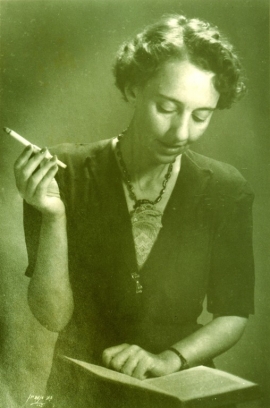 |
Goldberg had a vast knowledge of art history. In her youth she studied art and was familiar with the various styles of visual art, not merely from theoretical study but also from practicing various artistic techniques.
Drawing was a private and personal matter for her. She focused on the work itself, disregarding the audience's taste or the effect on the viewer.
Her artworks were made spontaneously, not concentrating on the technique, but mainly as an expression of ideas, emotional symbolic. Over the years she developed her own personal style. In her drawings and illustrations Goldberg engaged with materials from her literary work, both her own original writing and the classical works that she translated. She often turned the characters of heroes from literature into drawings, paintings or collage artworks or other images conjured from her fertile imagination. Some of her works resemble theatrical decor derived from her stories. Others may describe events from her life, and on occasion we can discern her own portrait, clearly stated or implied, as a heroine standing on stage in the center of the image, as mise en scene, or in the shadows, as a ghostwriter.
In 1923, then twelve years old, Goldberg noted in her diary that she wanted to be a writer or a painter. She remarked that while she no longer studied music, she continued to paint and her paintings were "not bad at all." When life at home became stressful, she drew to ease her distress.
"I paint, I am learning to paint, and it interests me. Perhaps I have talent."
In order to finance art lessons she tutored other students in subjects such as languages, in which she excelled.
After visiting an exhibition of a well-known painter she wrote in her diary:
"I liked it, it was interesting and beautiful, but there was nothing that will affect and speak directly to the soul" (Goldberg diaries, 04.13.1925, p 55).
She was a perceptive and intuitive judge of painting:
"Painting is not only beautiful, aesthetically pleasing, but speaks directly to the soul, it affects the emotions."
She described the excitement she felt in anticipation of the completed painting. If pleased with the result, she even found the work suitable for framing and hanging on the wall.
Eventually, under the influence of her family, especially her mother, she turned to writing as her main preoccupation. She nevertheless continued to paint and to draw, especially during hard times, and when she experienced difficulty in writing, she found painting comforting and relaxing.
In her drawing, her hand expressed overwhelming feelings and thoughts, which were substitutes for words. The image’s shapes and colors took the place of letters and words.
In a few simple words of a young girl, Goldberg expressed the essence of the experience of art upon viewing a small watercolor by Cézanne at the local Museum in her hometown Kovno (Lithuania). She recalled the sense of color and the impression of the brush strokes on the image, understanding the complex and abstract concept that an image need not necessarily be an accurate or realistic depiction of reality. |
Later in life Goldberg was able to view original artworks in exhibitions and to visit famous museums and wrote about her impressions of the artists and works that she particularly loved. However, her early instinctive expression of her first artistic experience, remained with her, as she testified many years later.
Lea Goldberg’s works of art address various topics: memories, impressions from her travels, nature and landscape, fantasy and reality. Many of her paintings portray characters that appear in her literary works or in books she translated or greatly admired.
The initial expression of the image was jotted down in her sketchbook or on random sheets of paper. She would often remark that drawing was the basis for all artwork.
She would draw multiple versions of the same image from different points of view and then paint or color them. The drawings were done in black ink, colored pencils, charcoal, gouache, watercolors and she even made some oil paintings.
Sometimes she drew on anything that came to hand, such as an invitation to an academic lecture at the university, or the schedule of a conference on Medieval Literature in Italy. Some pages were reused by drawing on both sides.
The drawings were done in freehand, intuitively, with quick lines, as if driven by emotion. The lines appear to be drawn almost impulsively, expressively, without planning. Yet upon closer inspection, one can observe details that betray a pre-designed composition.
|
 |
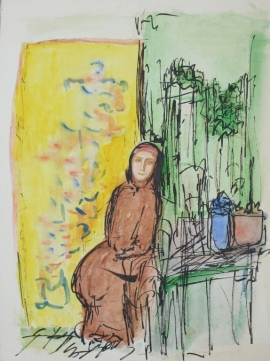 |
The characters Goldberg created appear to be carefully staged; they relate to one another as if engaged in dialogue. Some of her pictures display a depth achieved by single- or double-point perspective, or by criss-cross lines, for example by tiles or roads that merge at the vanishing point.
Other paintings are flat, with only a few lines, just enough to define the shapes. Some of the paintings seem to be framed by the surrounding shapes and lines. Paintings depicting landscapes, such as the paintings of nature, fields, forests and flowers, are usually spread across the page with a single emphasized figure, such as a single tree at the edge of the image. Most of her artworks are not signed or dated. Only a few works bear a Hebrew signature, handwritten or printed, specifying the year. Sometimes the signature is in Latin, and some illustrations from Greek plays bear a graphic signature that resembles Greek letters.
|
 |
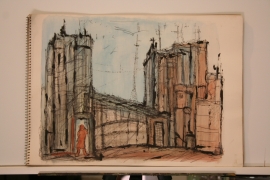 |
The series of collages made out of mixed media of paper date from her final years, 1968 to 1969, and address new issues such as the Bible, Jerusalem, and the notions of Time and Fate.
The combinations of pieces of paper, cut out and glued into new shapes, are reminiscent of the stained glass windows found in Medieval and Renaissance churches. Like the stained glass made of various materials and parts, glass and steel, assembled to create an entirely new entity, these paper collage works, with the addition of a few water color lines, result in a whole new composition. Some of the collages are constructed in an elongated rectangular shape topped with a round curve, reminding of the shape of church windows. |
 |
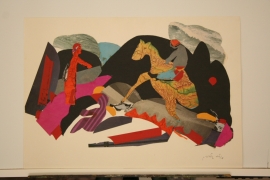 |
While most of the illustrations in Goldberg’s vast literary work were done by other artists, a few of her books include illustrations of her own. After many years of drawing as a private and personal activity, in her final years she displayed the collage artworks in two exhibitions held at the Artists House in Jerusalem in 1968 and at Kfar Menahem in 1969. As she notes in her article "Life Story," the exhibition of her works shows her desire to reveal her artworks to the general public, apparently because, aware of her illness, Goldberg suspected she was nearing the end of her life.
In her final days, with the last of her strength, Goldberg drew figures, landscapes and memories on the wall next to her bed, finding comfort in painting in her last moments.
|
 |
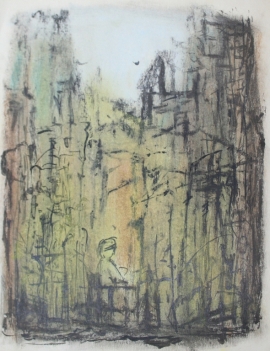 |
Lea Goldberg was a truly renaissance and multi-disciplinary artist. Her oeuvre spans vast areas such as poetry, drama, stories, translations of the classics, philosophical essays, children's stories and even commercial advertisements. Her works were published during her life and many were published only after her death.
Much has been written about her and her works: biographies, her diaries, and many research papers were published on her literary work.
Her artwork as a whole, drawing, painting and collage, never had the same impact as as her literary work. However, a closer look at her artwork reveals a rich artistic language, symbolic in nature, emanating from an inner need, expressing emotion but also showing signs of precision and meticulous design.
This part of her creative work is of special significance. It is based on and emanates from her personal emotional experience, sometimes providing relief from pain, and not intended for the public eye.
In my opinion, her artworks derive from the same source of inspiration as her literary work, and should be considered a complementary layer and an integral part of her overall artistic expression.
(Based on the article by the exhibition curator Ady Greenfeld in the exhibition catalog.)
|
 |
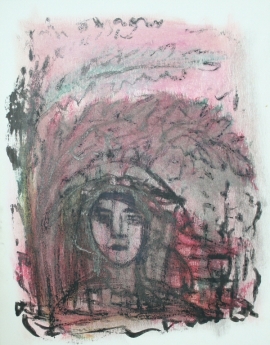 |
This unique exhibition at Tal Gallery offers a rare opportunity to become aquatinted with Lea Goldberg's drawings, paintings and collages and even with some of the original sketchbooks of this well-known poet.
The Exhibition catalog includes an original essay by Lea Goldberg titled "Life Story," written for the exhibition of her works that was held at the Artists House in Jerusalem in 1968. The catalog also includes a short article by Mr. Landau, the son of Mina Landoi, a close friend of Lea Goldberg; an article by Gideon Tikotzky, a researcher who has written several books and essays on Goldberg and studied her work; and an article by Ady Greenfield, the exhibition curator.
The exhibition presents works from the private collection Mr. Yair Landau, manager of the Goldberg estate and the Lea Goldberg Memorial Association, and collage artworks that loaned by courtesy of the "Gnazim" Archives, founded by the Israeli Writers Association.
The Festive Opening of the exhibition will take place on Saturday 22 June 2013 at 12 at Tal gallery, Kfar Vradim.
The occasion will include speeches and the performance of a few songs based on Goldberg's lyrics. |
|
 ראשי
ראשי  אודות הגלריה
אודות הגלריה  טל גרינפלד
טל גרינפלד  הדרכות בגלריה
הדרכות בגלריה  קבצים
קבצים  הודעות
הודעות  צור קשר
צור קשר  English
English 




